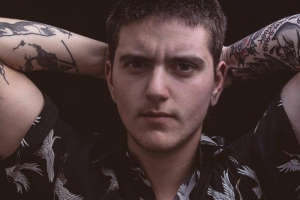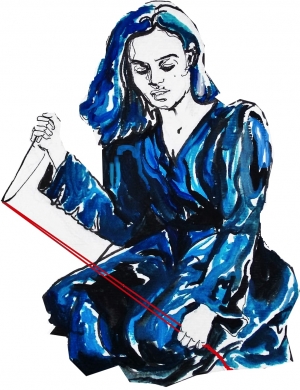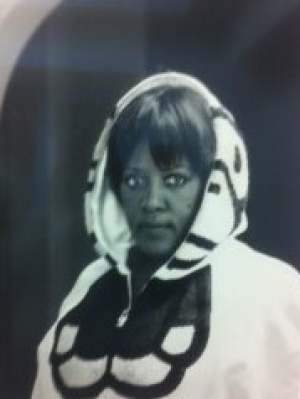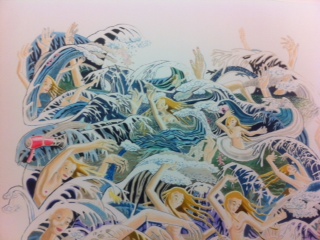Yvette Vieira
7th Spontaneous festival


The 7th edition returns to Sintra from February 15th to 18th, and has confirmed the presence of artists from Israel, Brazil, USA, Spain, Portugal and promises to show what is best in the universe of theatrical improvisation at the Olga Cadaval Cultural Center.
Of the main shows, the debut in Portugal of the acclaimed improviser and Brazilian comedian Márcio Ballas stands out, who presents for the first time his solo show titled "Luggage".
In addition to this unique debut, the audience will also have the opportunity to watch improvised ensembles with the participation of all improvisers invited to the festival.
Spontaneous also promotes, during the days of the festival, workshops of improvisation for professionals of the arts and curious. It is a co-production of the Snapshots with the Municipality of Sintra and is nominated for the Iberian Festival Awards 2018, in the category of best non-musical festival.
Throughout its 6 editions, the International Festival of Theater improvisation, brought to Portugal the biggest names in the world of improvisation and unique, hilarious and surprising shows.
Festival Program
15th of February - Thursday
9:30 pm - Yvonne Landry & Andy Coen (USA) - YVONNE AND ANDY
(interval)
22:45 - Impro Ensemble - GAME.SHOW.LIVE (International Cast)
16th of February - Friday
9:30 pm - Teatro Improviso Salvador (BR) - THE FLOWER OF THE SKIN
(interval)
22h30 - Márcio Ballas (BR) - MÁRCIO BALLAS A SOLO
17th of February - Saturday
9:30 PM - Impro Ensemble (International Cast) - TO BE OR NOT TO BE SHAKESPEARE
(interval)
22h30 - Impromadrid (ES) - GARDENS February 18 - Sunday 9:30 pm - Imbal Lori (ISR) and Paula Galimberti (ES) - FUN FATALE
More information at www.espontaneo.pt
The carrier of words

Valter Lobo is a young singer whose songs from his first album "Mediterrâneo" remind us of a more open and solar journey than his earlier, more intimate work entitled "Winter."
You are a lawyer by training what made you choose the music too?
Valter Lobo: It was a decision that turned out to be natural, because I had this artistic part in me for a long time. I wrote some songs in a timid way and decided at the end of my training that it was the right time to dedicate myself to music.
But you also have a musical background?
VL: No. My musical background is law. (laughs) I'm a self-taught guitarist, I've learned to play guitar for many years, I've always been composing at home and already at the end of college I decided to compete with my songs, I did an EP called "Winter" in 2012 that was relaunched in 2013, was a set of 5 very melancholy songs and this aroused the attention of the national radios.
Then you released your first Mediterranean album in 2016.
VL: I finally released my first album almost 5 years later, or 3 years after the reissue. This work of originals has now a year and I have been presenting it in concert halls, events and in some festivals.
What does this record stand for by comparing it to your first album?
VL: It represents my growth and at the same time they are interconnected, since it is the transition from winter to a milder climate. My first record was more closed, more diffuse, sadder, it's a hut on a mountain. Now, this is a trip up close to the sea, stripped of materialism and imbued with a spirit of non-sacrifice, here I go to a balcony in the Mediterranean.
I find it curious that you say this, because when I listened to the two albums, I continued to think that they were both bucolic, which refer us to romantic and solitary settings. In terms of the lyrics there is a continuity although the sonority is not the same.
VL: Yes. There was an evolution also in this aspect, which is normal.
Did you take a few songs from "Winter" to "Mediterranean"?
VL: No, it's mainly songs and lyrics made for this album. The first song of the Mediterranean is "I am astonished at the door, I slam my feet on the threshold to warn, I end the retreat, I leave the voice to find me ..." that is, I am now heading for the trip. I am the same person who wrote it, but there are differences because the subject is not so melancholy and so sad, I am more in finding myself.
You write very poetic lyrics, do you do it daily, or only when you feel inspired?
VL: I do not have a direct answer to give you, I will not make it an exercise, I'll do the song and then come the theme of the lyrics and what I want to say and then I'll go there. I do not have rules, if I need I do a song in 3 minutes, the theme "I wish I was" was done in five minutes, maybe it was inspiration, I do not know.
When you write the lyrics are you also with the guitar at the same time?
VL: Almost always. I play a melody on the guitar and then the lyrics comes to my head and I'm humming it. I recorded the album without having the lyrics on the paper had them all memorized. I wrote them for the first time when I was doing artwork for the album cover, in which case I had to move them to the computer.
You mean you always carry words with you?
VL: Yes.
Are you are thinking of them to improve them?
VL: Yes, I can see all the lyrics written in my head. It's like I have a computer. I exchange one word for a better one, but I visualize all my blocks.
Concerning the sound evolution of the first record for the "Mediterranean", then what has changed? The guitar is still present, because you can listen it, but what did you decide to do differently in terms of melody?
VL: I've worked with other musicians for this record. They added their part, because I also worked with another producer, I wanted to enter the world purely analogical, I have nothing too produced, are guitars, voices, trumpet and bass in its purest state. When the lyrics are genuine and not fictionalized you must have a melody that helps you convey that idea, or concept. As there is a natural evolution this calls more people to play these songs.
Unlike "Winter".
VL: In this EP it's me and one other person. It's more digital work. The "Mediterranean" is more organic and analogous.
Do you have words now in your head for an upcoming album?
VL: I have
And you're going to record it next year?
VL: Yes, it's already being written now, I always had the idea of writing an album entitled "I tell you everything" and then in all the songs the person opens completely.
So, you create characters that tell their story?
VL: Yes, I think it would be more viable.
You continue with that melancholy tone?
VL: Yes, I think so, because my voice refers to that kind of feeling. I can sing the most joyous thing in the world that my most serious and hoarse tone makes it look like this. I made the experience of putting other people to sing my songs and they sounded different.
And you thought about it, to have other singers participate in your songs?
VL: Not anymore. It is so intimate that to give yourself to someone else would end up distorting my work. I have collaborations with other musicians, I sing, but outside Valter Lobo.
Because you have such an intimate repertoire, it does not make sense to sing it in the big concert halls?
VL: I think it makes more sense in a theater, but I've played in bigger rooms and it worked.
And who are your audience? Already you notice them?
VL: Yes, it's not on a large scale, because I do not think I've reached the public, so I cannot know. But from children to seniors who like alternative music, or popular music, they are the ones who listen most to my themes. It also goes through young adults who are looking for different music.
Is it more of a female audience?
VL: Yes, thankfully. There is also a male audience, but for them arrives faster, it is also natural, it was not purposeful.
And you always sing in Portuguese?
VL: Yes, my language is the only one I master, and I do not want to sing bad English that I hear in most people.
You will leave the law and dedicate yourself to music alone?
VL: I'm a lawyer in the copyright section, in Porto. I work with many artists and I do not intend to leave in any way the law to the service of music and art.
Are you always going to keep these two facets in parallel?
VL: Yes, and I have one more, programmer and producer.
Do you produce other singers?
VL: Yes, I organize a cycle of singer-songwriting concerts and I have other projects to produce concerts and events with other artists.
The winter here and beyond

The fall/winter 2017-18 collection from Alexandra Moura and Alves/Gonçalves are introspective.
Always fascinated by distant cultures, identity, and History, Alexandra Moura finds in the historical period of the Portuguese expansion a romantic
and nostalgic heritage that still today distinguishes Portugal in the world.
For Autumn/Winter 2017/2018, the collection is looking to build a stronger connection with nature and ancestral origins, drawing its inspiration in the
Portuguese colonial empire in the XVIII century, and its presence in East-Timor, reaching up to Indonesia. Following this ancient intercultural dialogue, all of the opposing forces in the colonial past of Alexandra’s homeland are summarized as an important influence on the construction of such an intriguing identity, both in Portugal and the island of Timor, up to present days.
The iconic deconstruction work of contemporary pieces borrows subtle details from ethnic clothing and European romanticism. Traditional fabrics and prints from Timor and Indonesia are motifs to the jacquard sweaters with a shredded effect, suggesting impressions of the passage of time and distant memories.
Ranging from ochre tones to brown mixed with dark tones which contrasts with the light blue,the yellow and golden tones. Jacquard with lamé, sweatshirt, thick wool and trench are manipulated to create new tweaked silhouettes and bold volumes for a sensitive and contemporary customer who values uniqueness.

Alves/Gonçalves present a mixture of patterns and materials in an emotional, eclectic and individualistic potpourri.
Casual overlays are evident, where the classical is brought back and the masculine and the feminine intercept.
The loose, tailored volumes go hand in hand with the fluid nature of the prints and loose white shirts. There are technical finishes on the pleats. Denim is mixed with fur, giving an urban look.
This collection finds simplicity in the straight, feminine cuts. Silk, velvet, cashmere and denim are the main characters in this quest for authenticity
All is and is not

It is a book of prose by also writer Manuel Alegre.
Never has a title reflected so well the contents of the book, "Everything is and is not" shows his unique own style of writing and narrative in which nothing is what it seems. It was a book that hook me and confused at the same time, when I finished I asked myself, was it the story about a character, Antonio Valadares, who has a recurring dream? Or was it the story of an obsessive dream of the own narrator, Manuel Alegre? I refrain from responding simply because I feel like it. If you're curious read it and decide for yourself, what I can say about this book and going back a little bit is that the concepts of space and time and fiction and reality are subverted, dualities that make reading even more staggering and compulsive. Then, there is still room for several political epistemological discussions that refer us to the actual life of the author. In conclusion, I liked in general the creative narrative of the writer, I would even say that it is unusual when one considers that Manuel Alegre is one of the most remarkable names of Portuguese poetry and that contrary to what is thought not always a greater poet can be the at same time a great writer or vice versa, in the concrete case of this author I would say that it is 60/40. I was therefore pleased to read the surprising prose from this author and I can add to the skeptics that the writing is accessible, and it is not a 400-page book. You can read it and re-read very easily. Have a nice reading.
Canas 44

Com direcção artística de Victor Hugo Pontes e interpretação de Leonor Keil e de Rafaela Santos, será apresentado de 25 a 27 de Janeiro pelas 21h30 e no dia 28 pelas 16h30 na sala Estúdio Amélia Rey Colaço - Robles Monteiro, no Teatro Nacional Dona Maria II.
O espectáculo está integrado no ciclo Portugal em vias de extinção, promovido pelo Teatro Nacional Dona Maria II, e tem como metáfora de reflexão artística a própria biografia das intérpretes para, a partir das suas vivências enquanto cidadãs-artistas-mães-mulheres a viver em Canas de Senhorim, potenciar a reflexão maior acerca do país em que vivemos e em que viveremos nos próximos anos. Portugal que país será e quem seremos nós os cidadãos desse país?
Sinopse
Neste espectáculo há uma personagem que chega e há uma personagem que parte. Uma quer construir uma vida nova e a outra quer partir para ganhar mundo. Em comum, o mesmo lugar, Canas de Senhorim, que nunca é mencionado e, por isso, Canas é todos os lugares. Têm ainda em comum o número quarenta e quatro – anos de idade. A partir daqui constrói-se um universo autoficcional que especula sobre pessoas, lugares, ruas, que já não existem ou que estão em vias de desaparecimento, numa constante enumeração dessa memorabillia, como um movimento contínuo entre utopia e catástrofe, como se ressuscitar os mortos fosse uma forma de inscrevê-los na História.
Canas 44, co-produção Amarelo Silvestre, Nome Próprio, TNDMII, Centro de Arte de Ovar e Câmara Municipal de Nelas, já passou por Canas de Senhorim, Ovar, Covilhã e Sever do Vouga.
Canas 44
direcção artística e dramaturgia Victor Hugo Pontes com
textos de Maria Gil e Fernando Giestas
interpretação Leonor Keil e Rafaela Santos
espaço cénico Henrique Ralheta
desenho de luz Cristóvão Cunha
música original Rui Lima e Sérgio Martins
adereços Lira
projeto paralelo* Fernando Giestas
apoio à montagem Carolina Reis
produção executiva Susana Rocha
apoio à produção Nome Próprio
co-produção Amarelo Silvestre, Nome Próprio, TNDMII, Centro de Arte de Ovar, Câmara Municipal de Nelas
apoio República Portuguesa – Cultura / Direção-Geral das Artes
parceria As Casas do Visconde
outros apoios Associação Humanitária dos Bombeiros Voluntários de Canas de Senhorim, Borgstena, Patinter
*com o Agrupamento de Escolas e o Centro Social e Paroquial de Canas de Senhorim
Duração 60'
M/12
R.I.P 2 my youth
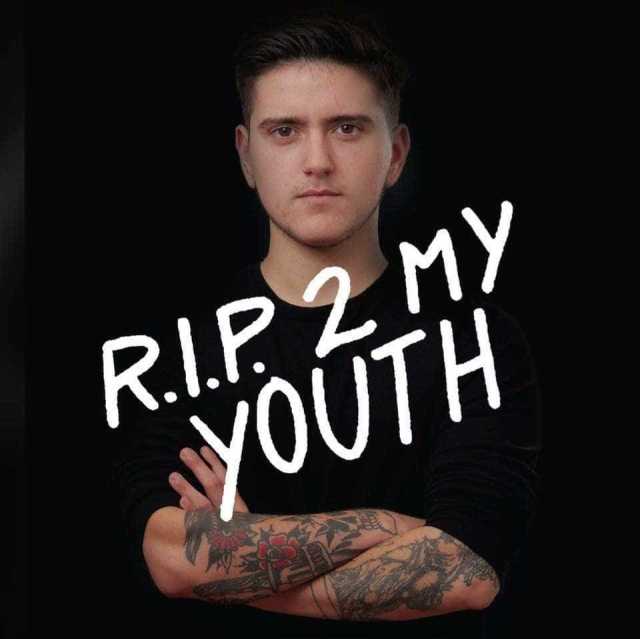
Documentário português sobre Transexualidade é apresentado na Madeira
A convite da Câmara Municipal do Funchal, o documentário português “Rip 2 My Youth” que retrata a história de um jovem transexual vai ser apresentado no Funchal, no dia 18 de Janeiro, pelas 21h00 no Teatro Municipal Baltazar Dias, numa sessão aberta ao público e com entrada livre e já é possível adquirir o bilhete na bilheteira do Teatro Municipal Baltazar Dias).
Realizado por um grupo de alunos do Mestrado de Audiovisual e Multimédia da Escola Superior de Comunicação Social (ESCS), “Rip 2 My Youth” conta a história real de Isaac dos Santos, um jovem de 20 anos, que passou pelo processo de transição de género. Desde muito novo que Isaac percebeu que não se identificava com o sexo feminino, tendo decidido mudar a sua vida e o seu corpo quando tinha apenas 18 anos.
Em “Rip 2 My Youth” é relatado todo o processo de transformação de Isaac num percurso duro mas gratificante, marcado pelo seu forte carisma e determinação.
O documentário é co-produzido pela Comprimido, agência de web vídeo marketing, e é um dos primeiros filmes sobre transexualidade realizados em Portugal, com um testemunho real e uma história positiva sobre um dos temas mais fraturantes e tabu da sociedade atual.
Depois das sessões em Lisboa e Porto, o Funchal é a terceira cidade a receber “RIP 2 My Youth”, seguindo-se brevemente mais exibições por todo Portugal.
Ficha Técnica Realização: João Pico, Elizabeth Vieira, João Figueiredo
Produção: Elizabeth Vieira
Edição: João Pico e João Figueiredo
Assistente de Edição: Hugo Louro
Adaptação do Guião: João Gama, Susana Maciel
Guião Original: Mariana Ramos
Captação de Imagem: João Pico, Elizabeth Vieira, João Figueiredo, Susana Maciel
Captação de Som: Elizabeth Vieira, João Gama
Pós-Produção de Áudio: InSonik
Música: João Pico
A noite da dona luciana

No próximo sábado, 9 de Dezembro às 21H30, o Cine-Teatro João Verde em Monção recebe A NOITE DA DONA LUCIANA de Copi.
A NOITE DE DONA LUCIANA de Copi
Tradução ISABEL ALVES Encenação RICARDO NEVES-NEVES Assistência de encenação CATARINA RÔLO SALGUEIRO Elenco CUSTÓDIA GALLEGO, JOSÉ LEITE, MÁRCIA CARDOSO, RAFAEL GOMES, RITA CRUZ e VÍTOR OLIVEIRA Figurinos JOSÉ ANTÓNIO TENENTE Luz ELDUPLO Técnico de Luz SIMÃO SOARES Música SÉRGIO DELGADO Fotografias ALÍPIO PADILHA Vídeo Promocional EDUARDO BREDA Apoio ao espectáculo EMANUEL SANTOS Comunicação MAFALDA SIMÕES Um espectáculo TEATRO DO ELÉCTRICO M16 Duração 70 min
O espectáculo já foi apresentado em Lisboa, Leiria, Vila Velha de Ródão, Funchal, Matosinhos, Loulé e Torres Novas. Tem sessões agendadas para Condeixa-a-Nova, Tondela, Almada e Açores.
O espectáculo teve duas nomeações para os Prémios da Sociedade Portuguesa de Autores: Melhor Espectáculo do Ano e Melhor Actriz do Ano (Rita Cruz).
Cine-Teatro João Verde – Monção (9 de Dezembro, 21H30)
Reservas: 251 649 013
Rips

This is the third play written by Jorge Ribeiro de Castro, and staged by the company Bolo do Caco Theatre.
For the playrwriter, "as always, it is a journey through the most intimate and dissonant of the human being, emphasizing a reality in which society does not care about moral values, is consuming and harmful. Two brothers live in the same house, but despite the education they have been equal, there are many differences between the two, whether on an emotional, intellectual or behavioral level. To confuse the story even more, a strange element emerges..."
For the actor the play verses the history of "Two brothers, two ambitions, two coffees, two sides of the same coin, a woman, an inheritance, and a cigarette. Will a murderer and a detective be the two faces of the same person? When wills collide, the inner ambiguity of human morality reveals itself, like a plunge into a deep, dark pit. The tools of ambition go through lust, violence and cruelty, even among blood of the same blood. By adding estrogen to this already potentially flammable mixture, we run the risk of witnessing a true pyrotechnic show. He had already advised Shakespeare not to quarrel with a woman, for they are lunatics!"
Tecnical Sheet:
Text: Jorge Ribeiro de Castro
Screenplay: Xavier Miguel
Stage Management and Scene Directior: Mariana Faria
Scenographies and Costumes: collective
Sonoplasty; Xavier Miguel and Óscar Silva
Drawing of Light: Xavier Miguel and José Zyberchema
Illustration: Fátima Spínola
Poster: Miguel Xavier
Production: Xavier Miguel
Technical Support / Assembly: José Zyberchema and Óscar Silva
Cast:
Vladimiro-Óscar Silva
Norival-Pedro Santos
Elvina-Mariana Faria
? -Catarina Serrão
Chalender:
December 2017
Balcão Cristal
Day 1, 20h/22h
Day 2, 22h
Dia 3, 19h/21h
Duration aprox: 45min
Reservations/Bookings:96195271
teatrobolodocaco@gmail.com
A walk thru the docks of albert and victoria

It is the second part of my journey that begins on the Atlantic coast, overlooking the Table Mountain in South Africa. Follow me.
The Victoria and Albert Waterfront represents one of the must-see spots in Cape Town, over 400,000 square meters of shops, hotels, restaurants, shopping centers, entertainment and concert halls, which are visited on average by 24 million of people per year, 23% of whom are tourists. The renovation of these two basins of the port of Cape town started in 1988, the project aimed to revitalize a vast area with several abandoned port infrastructures that were being modernized in phases and transformed into different thematic spaces.

One of these must-sees, right in the heart of this area is the Watershed, an old warehouse that houses hundreds of small stands of African artists and designers. It's all very beautiful and original, the great difficult is the choice. This is only anyone who likes African art!

But, the new crown jewel, in my view, was the opening of the Zeistz Museum of Contemporary Art of South Africa (Zeistz MOCAA), the largest of continent and the diaspora that permanently present African art. The mega project was the result of a partnership between the company that manages V & AW and a German investor Jochen Zeistz with the aim of rehabilitating one of the port's oldest grain silos, which operated for nearly 80 years. The rehabilitation work by a London-based architectural firm, the “Heatherwich studio”, sought to preserve the architectural and industrial legacy of what had been for a long time one of the city's tallest buildings, with its towering 57 meters and result of all these synergies is simply superb.
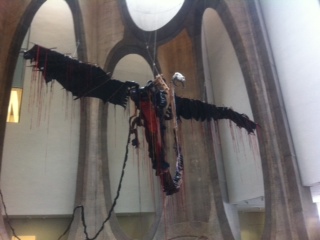
The museum deserves a visit for several reasons, one of them relates to the excellent work of rehabilitation of the silo. The lobby remain me the atrium of a cathedral, due to the exposed clipping of the cereal tubes, looks like the inside of a bee hive! And with a plus the work by Nicholas Hlobo called "iimpundulu zonke ziyandilandela", the lightning bird, inspired by a Xhosa legend, the location could not have been better, gives it a neo-futuristic atmosphere. The infrastructure itself has not been painted, it maintains its massive and concreted interior, where the highlight goes to the crudeness of its tubular lines underlined by the staircase in bias and the metallic elevator. The ground zero, is another discovery, is like being inside a cut out cocoon from where we can appreciate all this industrial surrounding that envolves us.
Glass has played a very important role in several of the floors, let's say that its transparency further enhances the austere features of the building without too much adulteration, the highlight goes to the top with its diamond-shaped windows where the sculpture garden is located, a cafe and a hotel. It's true, Zeistz MOCAA is not only a museum space, it only works as such, for now, on Friday, over the weekend and Monday, the other days is a business center, entrepreneurship and has specific spaces for events or conventions.
But let us return to what interests me the most ...the artistic work, the various works exhibited in the ZMOCAA come from the private collection of Jochen Zeistz, a long-term loan, which is the cornerstone of this extensive exhibition, as well as of course, the temporary exhibitions that oversee by different curators. I was really fascinated with several of the artists, it is not at all common, at least for a European, to appreciate these contemporary "looks" in a single space and I have to show you some of the pieces and pictorial works exposed. On the other hand, I would like to point out that the selected images are not intended to detract from the work of the other artists. On the contrary, it is only a collection that aims to show the reader what is some of the best art work on the African continent.

Arranged on the various floors are a group of artists who revisit the concept of clothing, through a narrative whose center is the body and where there is a reinterpretation of the materials. Athi-Patra Ruga, Yinka Shonibare, Leonce Raphael Agbodjélou and Nandipha Mntambo use different artistic supports in order to materialize the symbiotic relationship between humans, nature and their surroundings and above is the work of Kudzanai-Chiurai called "Revelations".

This second block includes two types of artistic vehicles, installations and painting. In this context, El Anatsui is a Ghanaian artist who reuses in his work disposable materials from Europe and the Americas that were introduced in Africa. The hyperrealist Jeremiah Quarshie questions the notion of the imaginary and investigates the nature of art and Marlene Steyn paints vivid, diaphanous and complex universes inspired by psychoanalytic theory

And right next to the ZMOCAA when climbing the stairs in the clock tower, beauty takes on other forms that I strongly advise for lovers of the crystallized carbon atoms, the diamond museum. Elisabeth Taylor said rightly, diamonds are forever and is the purest of truths. The guided tour has a maximum capacity and sometimes it is necessary to schedule, particularly at the weekend, I can guarantee that it is worthwhile, the course includes a little history of diamond mining in South Africa, the most important personalities of this sector , the replicas of the most famous diamonds in the world and a stop by the cutting studio, there you can see in action the meticulous work of what I call the artisans of brilliance, who carefully carve and polish each gem with great precision and minutia.
And after having fed the soul, nothing better to appease the physical hunger than a visit to another of the essential points of the sea front, is the "W & F food market", it is not a traditional space where fruits and vegetables are sold, is a place to sample local delicacies and where you can eat a meal if you wish, not to mention a varied and quality offer. The most interesting are the various stands of small agricultural producers and gastronomic entrepreneurs who expose their regional products, and all this deserves a curious bite.
https://zeitzmocaa.museum/
http://www.capetowndiamondmuseum.org/about-the-museum/
http://www.waterfront.co.za/vanda/about
The musical kastrupian

Guilherme Kastrup is one of the instrumentalist musicians and most recognized musical producers in the Brazilian music scene. Although he has a professional track with more than two decades was only in 2013 that it released its first solo album and he promises to do the same feat already next year, when it reaches its point of mutation.
You are a musician already with a long career, you produced immense reputed artists in Brazil, why only in 2013 you decide to make an album in your own name?
Guilherme Kastrup: I never thought much about this solo career story, or author. My vocation is as an instrumentalist musician and I lived through it for many years. Then I started to get interested in the studio part, to record and produce some things. In this process I started to play with some things, as an authorial play, but without any pretension. This record was built over a long time, ten years, from studio plays and I began to recognize that I had a work that deserved to be released with soul. I started to organize this with the thought of an album.
You are a percussionist, but the album has a very technological part. How did you go from this instrumental phase to the digitized sounds?
GK: I think it was two interests at the same time. This part of tinkering with the sampling and clipping of digital music is a thing of playing in a percussive way with various sounds that are not instruments initially recorded and repositioned with this characteristic that the sample can give. You play with electronic drums and recorded sounds from a variety of backgrounds and that's what really interested me and what I discovered. The other part is the studio recording, of production in which I dived deep into the background, did recording, clipping, that much of the digital music and editing, is a bit like the plastic arts. This cross between plastic arts and music is what has made this desire to do a very bright authorial work.
What sounds did you record? We can hear that you have animals, sometimes they seem to be more urban sounds.
GK: I record a little bit of everything, as you realized, there are ten urban sounds of machines, cars and this intense thing that the city has and there are also more dreamlike sounds of cicadas, birds, speeches and interviews. There is a song that is an interview of Cartola that I cut and transform into music from its scanning, it's a cut and paste game that allows me to do things in a way as if I had composed electronic music, only from acoustic elements of all origins.
Then how did you choose these cuts, in the middle of so many topics what was the selection criterion?
GK: There was a lot of playing, but it was choosing those that could form a set, most of the songs were born from the precursor itself, I moved with them, I discovered melodic themes in those tracks and then the themes started to be developed and only then I started to think about the whole. I really like this thing about the creation of the album, the idea of a record with beginning, middle and end and that the songs have connections between them, is something that was part of the selection so that the songs had in this set of "Kastrupismo".
You called it "Kastrupismo" because it, was you? Because you are that?
GK: Yes,
It is the mark of the individual being, of a work with soul.
GK: Exactly, I used my own name, Kastrup, because it was like saying that this is my way of making music, my way of doing it.
Do you have some entries and some lyrics, did this come later?
GK: Some of the yes and no, for example, Cartola started with the idea of cutting three of the interviews in which he was telling about the first sale of his samba, his astonishment when they arrived next him and offered him money and he said, are you crazy, dud? My interest in this story made me want to do something interesting with it and started from the speech to music. Other songs started from rhythm by entering lyrics, but they do not work exactly like a song. Normally, I work a lot with songs, my career is based on this as an accompanist, percussionist, or music producer. In my personal journey I wanted to get away from that format a bit and use the complete poetry in a freer way in the music structure. What I use as a lyric is more the complete poetry that I can assemble, disassemble in several parts and reassemble in another way. Every hour it appears in a different way and I gave myself the freedom to play with poetry in a different way and to escape from the more closed format that is the song.
Then you present another album that is "Sounds of Survival", which I think has an extra poetic side and is very different from "Kastrupismo". Why the name?
GK: Benjamin Taubkin named it. "Sounds of survival" came from a duo of percussion I have with Simone Sou, a great percussionist and we created Soukast which is a joke with our names, we created a repertoire from the repercussion and later we invite Benjamin Taubkin who is a great pianist and Brazilian thinker. This encounter was very sparkling, the result was very interesting, and we decided to record this album. When Benjamin suggested this title, I also wondered and asked him, then I understood the poetic sense of the kind of music we make, which is the resistance of human politics, of how we see the world, more autonomous in the way of creating and facing the society where people are, is physical and artistic survival. "Sounds of survival" has to do with this, a certain act of resistance, the art of human relations.
You are a producer of your own musical projects, if not, do you think there would be a space for you in the Brazilian music scene? Because you're so different?
GK: I do not know (laughs). I never thought of it with this focus of being a producer of my musical projects. Sometimes I felt I needed an outward look to say stop. Now, I'm finishing my second album and I think I'm a better producer of myself than the first.
Is it a second exercise of Kastrupismo?
GK: It will no longer be a Kastrupismo, but it is an exercise in a slightly different kind of game, my life has changed and this time the beginning of the songs are not the repercussions, but it was some meetings that promoted improvised music. I formed two trios with artists with whom I have a lot of connection and we made improvisations, from that I began to collect this material to make the compositions.
But, you are touring with your first record, in the shows you play songs from this second album?
GK: Not yet, I have not finished it yet. I finished the creative process, I have the album all set up, how I like to do everything, I like to think about the order, how the songs intertwine, what their history is like in the general context of the album and from there, I go mixing, mastering, but for now I'm in the creative process. I have not shown it to anyone yet, but I played a first song already in Lisbon and in Madeira.
Do you have a phrase that defines this second album?
GK: This album is going to be called perhaps "Point of mutation" in reference to a book that I read, that I found very beautiful, of Fritjof Capra. It has a concept of seeing mankind as a single living organism and that is at that point of mutation. We are at the end of a period, a cycle, a time dominated by the yang, the male, to move to a more ying, more feminine phase. I found this image very poetic, a physicist who studies sociology, the concept is very beautiful, because we are at the end of a cycle of humanity, we see this capitalist system in an act of boiling and it has everything to do with it. The album has to do with this world now.
When we talk about music in Brazil, we talk of popular music, bossa nova and as I said from the beginning your sound is very different, it is something that is seen more in Europe and USA, but we never hear about it in your country. How is the Brazilian market for your kind of musicality?
GK: Brazil is very rich musically. What passes out is these stereotypes of bossa nova, samba, but internally we have a very large production, especially in cities like São Paulo that has a flow for this. There is a lot of people interested, there is a market that moves, it is possible to live independent and experimental music even though it is outside the main popular circuits that in Brazil is very intense.
Podcast
Eventos
-
Cineteatro louletano- Programa Abril
 12-02-2016
12-02-2016
De 15 a 19 de abril, existe outra oficina, também a assinalar os 50 anos da Revolução de Abril,...
-
Teatro Baltazar Dias-Programa Abril
 12-09-2015
12-09-2015
A nova programação do TBD para este mês é dedicado a Liberdade de expressão e criativa, aos...
-
Bairro da música- virgem suta e abril
 25-08-2015
25-08-2015
Virgem Suta estreiam temas do novo álbum no Festival Soam as Guitarras O concerto no Auditório...
-
CCVF e CIAJG- 11º Westway Lab
 06-06-2015
06-06-2015
11ª edição do Westway LAB confirma primeiros protagonistas – NewDad, Júlia Mestre, Luís Severo,...
-
Walk&Talk 2024
 06-06-2015
06-06-2015
Lançamento Catálogo 2011–2022 Dois anos de reorganização de arquivos físícos e digitais e de um...







